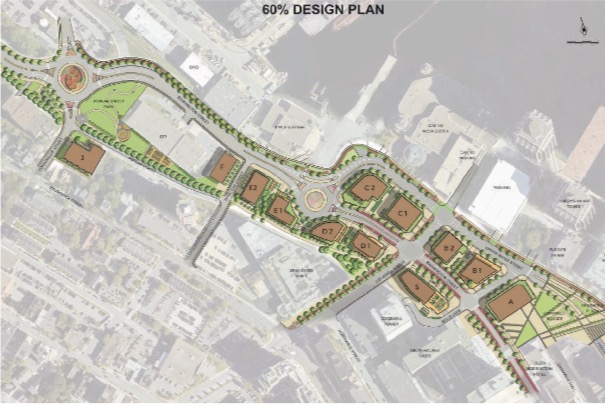25 Feb Activists kill a roundabout, ensuring more pollution and more pedestrian injuries

Ideologues in the active transportation movement scored a big win Friday when Halifax city staff agreed to ditch one of two roundabouts proposed for the Cogswell redesign. The 90-percent design that goes to Council for approval Tuesday accepts a consultant’s recommendation to replace the roundabout with an old-fashioned stoplight-controlled intersection.
The consultant is dead wrong. This change will produce more collisions, more injuries to pedestrians, increased risk of pedestrian deaths, higher fuel consumption, higher greenhouse gas emissions, and more exhaust fumes from idling car engines and diesel truck motors. The design change will create a less pleasant experience for shoppers, walkers, tourists, bicyclists, and other would-be users of this supposedly people-friendly space.
It’s a cockamamy decision. The overwhelming advantages of roundabouts are not controversial, except perhaps in the sense that human-caused climate change and mass vaccination programs are controversial.
A 2009 report for Transport Canada by the engineering firm AECOM said the superior safety of roundabouts had been so thoroughly demonstrated, additional studies were a waste of effort. Studies by the U.S. Federal Highway Administration and the Insurance Institute for Highway Safety showed that replacing signalized intersections with roundabouts produced a 37 percent reduction in collisions, a 75 percent reduction in injury collisions, a 90 percent reduction in fatal collisions, and a 40 percent reduction in pedestrian collisions. For more evidence, see here, here, here, here, here, here, here, here, here, here, here, here, here, here, here, here, here, here, here, here, here, here, here, here, and here.
For years, active transportation advocates have decried the frequency of car-pedestrians accidents in Halifax. The great majority of those collisions occur when inattentive drivers are turning at signalized intersections. Roundabouts reduce this risk because no one is turning. Traffic flows in one direction, with fewer points of conflict.
The same activists demand reduced speeds on the peninsula. The curvaceous geometry of roundabouts naturally slows cars, and no one is racing to catch a light because there is no light.
Last year, council voted to prioritize pedestrians and cyclists over cars in transportation planning. Some activists cite this commitment whenever they see any planning step that accommodates cars in any way.
Think about this for a moment. The Cogswell zone will be used hundreds of times a day by 18-wheelers traveling to and from the Halterm container terminal. It is the only route they can use. Halterm is a major economic asset for the city and the province. Short of moving it to Melford, Guysborough County, which might not be a terrible idea, those trucks are going to traverse the Cogswell site no matter how many artificial inconveniences activists can persuade council to throw up in their path.
Is activist hatred of drivers so intense they would rather their fellow pedestrians endure a line of idling diesels spewing fumes than let trucks and cars move through the area at a modest but steady pace? Apparently, for some, the chance to inconvenience drivers just a little is worth increased smog, GHGs, and pedestrian injuries.
For years I watched with dismay as rural and suburban councilors forced regressive planning decisions on downtown Halifax and Dartmouth. Lately I pray for a little country wisdom to prevail over ideology and holier-than-thou social engineering.
Councilors, look at the data. Have some sense. Put the rotary back where it belongs in a modern, progressive, evidence-driven city.
